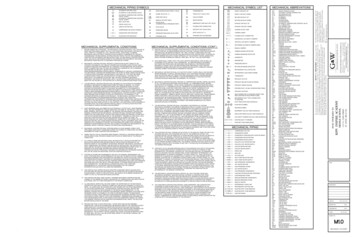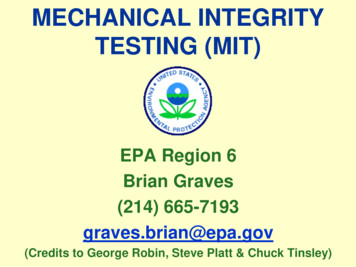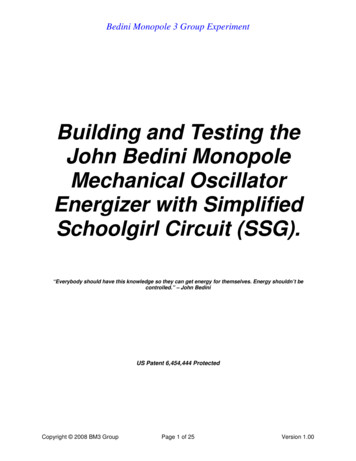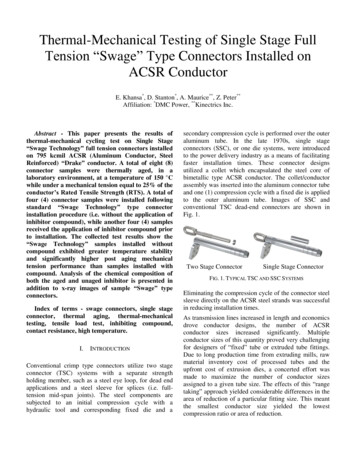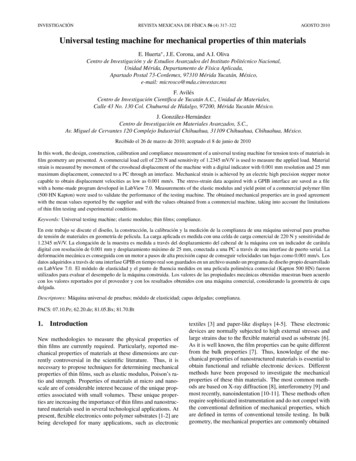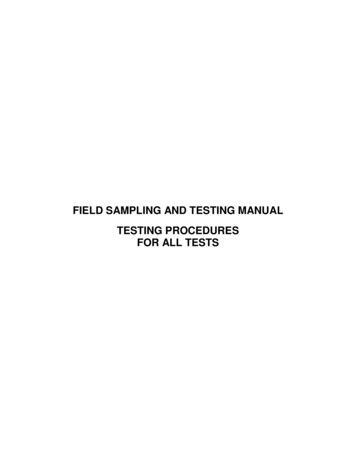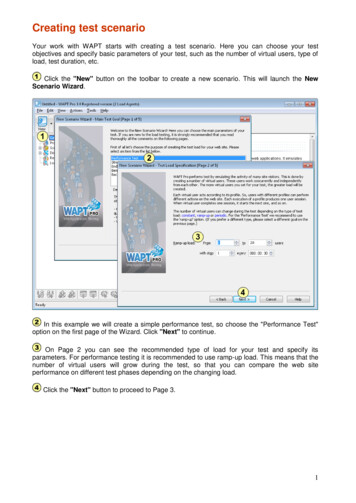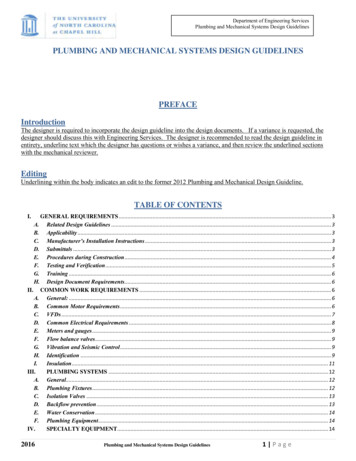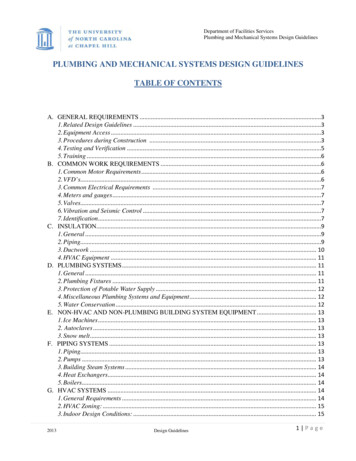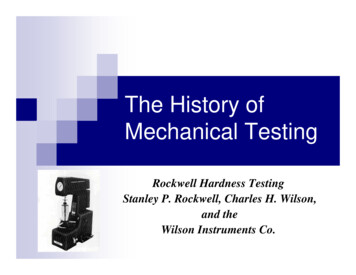
Transcription
The History ofMechanical TestingRockwell Hardness TestingStanley P. Rockwell, Charles H. Wilson,and theWilson Instruments Co.
This presentation is aboutThe inventor - Stanley P. RockwellandThe developer - Charles H. Wilson
CreditsMost of the information for this presentation came from thefollowing sources An article titled Hardness, Bearings, and The Rockwells,written by Richard E. Chinn of the National EnergyTechnology Laboratory, Albany, Oregon published in theOctober 2009 issue of Advanced Materials and Processesmagazine. A book titled Indentation Hardness Testing written byVincent E. Lysaght , first published in 1949
Stanley Prichard Rockwell(1886 – 1940) Stanley P. Rockwell was born in NewBritain CT. in 1886.He earned his degree from theSheffield Scientific School of YaleUniversityIn 1914 he worked as a testingengineer and metallurgist for the NewDeparture Mfg. Company in BristolCT.
Stanley P. Rockwell At that time New Departure not only made ball bearingsfor autos but full autos as well. One of their best knownproducts was the coaster brake used on bicycles that manyof us (old folks) used growing up. While at New Departure, Stanley worked with Hugh M.Rockwell. I first assumed them to be brothers, however,they apparently were not closely related if at all. Hugh was an avid aviator and automobile enthusiast. Heeventually followed his other interests while Stanley stayedwith metallurgy.
Stanley P. RockwellThe two Rockwell's spent a lot of their time together tryingto determine the hardness of bearing races. The only testsat the time were Brinell, Scleroscope and the file test. The Brinell test was very slow, and not suitable for smallradius curved surfaces and hardened steel. Plus the indentwas way too large to be non destructive. The Scleroscope test was suitable for hardened bearingsteels but it was very difficult to use and hard to getrepeatable results. The file test was useful but only as a go/no go test.
Stanley P. RockwellThe differential depth hardness measurement was firstdescribed in Vienna in 1908 by Ludwig in his bookDie Kegelprobe as a cone impression test.The method was proposed to be useful in eliminatingmechanical errors and surface roughness limitations.It is not known if the Rockwells were aware of this book,however, they were apparently the first to develop a workingapplication of the method.
Stanley P. RockwellStanley and Hugh Rockwell worked long and hard to arriveat the basic principle of using both a minor and major loadin measuring indentation hardness.They filed for a patent on July 15, 1914.The first patent, no 1294171 was granted onFeb.11, 1919.
Stanley andHugh Rockwell’soriginal patent
Stanley P. Rockwell Both Rockwells left New Departure before the patent wasissued. During WW1 Stanley served as a captain in the Armyordinance department. After the war Stanley Rockwell became the worksmanager and metallurgist for a company called Weeks andHoffman in Syracuse NY. At Weeks and Hoffman, he improved the design of thetester and applied for a second patent in Sept. 1919.
Stanley P. Rockwell In 1923 Stanley Rockwell started his own business inHartford CT. called the New England Heat TreatingService Co. The name was changed to the Stanley P. RockwellCompany in 1924. That company still exists today. Rockwell was a creative engineer who was always lookingfor a practical solution to a problem. He was a greatbeliever in the trial by error method and was known as ashop-man. He also was known to have had a keen sense ofhumor.
Stanley P. Rockwell In 1922 Rockwell presented a landmark paper on his testerduring the American Society for Steel treating conventionin Indianapolis IN. (ASST became what is now ASM in1933) In addition to Rockwell he was granted other patents. Themost notable for a device called a Dilatometer. It is used tomeasure the thermal expansion of steel. This was a largeproject that took more of his time than even the Rockwelltester.
Stanley P. Rockwell Stanley continued to develop the Rockwell tester by addinga dashpot to control the rate of loading. He applied for a third patent in May 1921 On Nov. 18, 1924 Rockwell was awarded two additionalpatents for the tester, no. 1516207 and 1516208.
This is a picture of anearly model tester builtby Stanley Rockwell totest more than justbearing races.
Stanley P. Rockwell In 1939 Stanley Rockwell was awarded the fifthAlbert Sauveur Achievement Award by ASM.The prestigious Sauveur award “recognizes pioneering materials science andengineering achievements that have stimulatedorganized work along similar lines to such extentthat a marked basic advance has been made in theknowledge of materials science and engineering”
Stanley P. Rockwell The Stanley P. Rockwell Co. provided heat treating servicesand sold furnaces made by the American Gas Furnace Co.and GE. In addition they also sold process instruments made byThe Wilson-Maeulen Co.
Charles H. Wilson Charles Wilson was an instrument salesman for theWilson-Maeulen Co. based in NY city. The Stanley P.Rockwell Company was one of his customers. In 1920 Wilson saw one to the first 10 machines thatRockwell built and realized the potential of the tester forshop testing as well as laboratories and research facilities. Wilson quickly worked a deal with Rockwell to take overthe development, manufacture and, sales of the Rockwelltester.
Charles H. WilsonIn Stanley Rockwell's words, it was Wilson who -“brought it to the attention of the public, sold it tothose who needed it, and thus created the businessand employment”
Charles H. WilsonDuring the 1920’s Wilson made several significantimprovements to the Rockwell Test and Tester. Wilson reversed the scale so that harder measurementswere higher numbers than soft measurements. This logicalchange made the Rockwell results like Brinell andScleroscope results. The original scale went from 100 to 0. Wilson recognized the importance of controlling the minorload (to that point called initial pressure). He standardizedon 10 kg and made sure it was carefully controlled toestablish a solid reference point.
Charles H. Wilson The original major load was 100kg and the originalindenter was a 1/16 diameter hardened steel ball. The steel ball did not work at all on hardened steel.Rockwell purposly flattened the balls to prevent furtherdeformation of the ball so he could test the hard bearingraces. This turned out not to be ideal since smalldifferences in hardness could not be detected with theflattened ball.
Charles H. WilsonIn 1924 Wilson made two major changes to resolve the problem. He developed the diamond Brale indenter for testinghardened steel. After much experimentation hestandardized on a diamond cone of 120 deg angle with a2micron radius tip tangent to the cone. On Feb. 2, 1926Wilson received a patent on his diamond Brale indenter. He changed the major load from 100kg to 150kg.The HRC scale was born
CharlesWilson’sdiamondindenter patent
Charles H. Wilson There was a problem when testing soft brass. The 100kgmajor load resulted in negative readings on materialsbelow B30. To solve the problem, Wilson increased thestarting scale from 100 to 130. This gave positive readingson soft materials and good sensitivity on hard brass.The HRB scale was born In on June 10, 1930 Wilson was granted his own patentno. 1762497.In 1932 the superficial scales were developed by Wilson totest thinner materials.The Rockwell test as we know it today was created.
Wilson's tester patent
Charles H. WilsonStandardization The first Rockwell standards, ASTM E18.32T and BSI#891:1940 were really only directions on how to use thetester to get good results and did not contain a completedefinition of the Rockwell hardness test. For example:- There was no defined test cycle.- There were no tolerances on the test loads.- There was no information on how to calculate theRockwell number from the depth measurement.How times have changed!!!!
ASTM E18-32T was aTentative Method under thecontrol of The Section on IndentationHardness Testing of CommitteeE-1 on Methods of Testing. The Tentative Standardswere published for purpose ofeliciting criticisms andsuggestions and as such weresubject to annual revision. The earliest version of E18 wecould find without theTentative title was E18-36.
Charles H. WilsonWith the success of the Rockwell tester theWilson-Maeulen Co. name was changed to -Wilson Mechanical Instruments Co.later shortened to -Wilson Instruments Co.
Wilson Instruments During WW2 production boomed. Wilson built Rockwell testers in the US andthe UK. Export orders were frequently place by coded telegraph messages. Forexample an order for 40 bushels of potatoes may have been used to indicate anorder for 40 4JR testers. Approximately 600 Rockwell testers were shipped to Russia. After the war Wilson thought they had saturated the market so they sold thebusiness to American Chain and Cable Co. (ACCO) located in Bridgeport CT. Wilson manufacturing was immediately moved from NY to Bridgeport CT.The sales offices, which were located at 230 Park Ave. in NY City, were movedto Bridgeport in 1970. In spite of the large number of testers built during the war, the Rockwellbusiness continued to grow under ACCO’s ownership. In 1988 Wilson Instruments was sold and since 1993 has been a part of InstronCorp. in Norwood MA.
Miscellaneous Stanley Rockwell died tragically in August of 1940, at theage of 54, when his 50ft yacht Chin-Chin exploded on theConnecticut river. He was an experienced sailor and aloneon the boat at the time. The cause of the explosion wasnever officially determined. The original Wilson-Maeulen products were sold to theFoxboro Co. in Foxboro MA in 1930. Foxboro is only 15miles from Instron the current location of WilsonInstruments.
A Wilson catalogfrom the late1920’s
The inside still showsthe Wilson-Maeulenname
A book titled Indentation Hardness Testing written by Vincent E. Lysaght , first published in 1949. Stanley Prichard Rockwell (1886 – 1940) Stanley P. Rockwell was born in New Britain CT. in 1886. He earned his degree from the Sheffield Scientific School of Yale University In 1914 he worked as a testing engineer and metallurgist for the New Departure Mfg. Company in Bristol CT. Stanley P .

